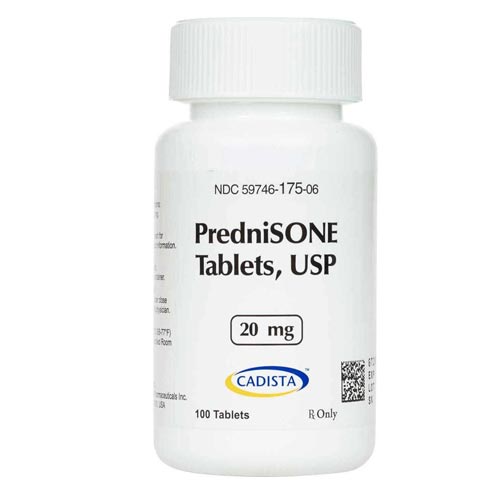Description
Prednisone is a synthetic anti-inflammatory glucocorticoid derived from cortisone. It is biologically inert and converted to prednisolone in the liver.
For the treatment of drug-induced allergic reactions, perennial or seasonal allergic rhinitis, serum sickness, giant cell arteritis acute rheumatic or nonrheumatic carditis, systemic dermatomyositis, systemic lupus erythematosus, atopic dermatitis, contact dermatitis, exfoliative dermatitis, bullous dermatitis herpetiformis, severe seborrheic dermatitis, severe (Stevens-Johnson syndrome) erythema multiforme, mycosis fungoides, pemphigus, severe psoriasis, acute adrenocortical insufficiency, Addison’s disease, secondary adrenocortical insufficiency, congenital adrenal hyperplasia, hypercalcemia associated with neoplasms, nonsuppurative thyroiditis, ulceratice colitis, Crohn’s disease, acquired hemolytic anemia, congenital hypoplastic anemia, erythroblastopenia, adult secondary thrombocytopenia, adult idiopathic thrombocytopenia purpura, acute or subacute bursitis, epicondylitis, acute nonspecific tenosynovitis, acute or chronic lymphocytic leukemia, Hodgkin’s or non-Hodgkin’s lynphomas, Waldenstrom’s macroglobulinemia, primary brain tumors (adjunct), nephrotic syndrome, tuberculous meningitis, multiple sclerosis, myasthenia gravis, cerebral edema, chorioretinitis, diffuse posterior choroiditis.
Pharmacodynamics
Prednisone, the most commonly-prescribed corticosteroid, is used to treat allograft rejection, asthma, systemic lupus erythematosus, and many other inflammatory states. Prednisone has some mineralocorticoid activity and thus may affect ion exchange in the kidney.
Mechanism of action
Prednisone is a glucocorticoid receptor agonist. It is first metabolized in the liver to its active form, prednisolone. Prednisolone crosses cell membranes and binds with high affinity to specific cytoplasmic receptors.
The result includes inhibition of leukocyte infiltration at the site of inflammation, interference in the function of mediators of inflammatory response, suppression of humoral immune responses, and reduction in edema or scar tissue. The antiinflammatory actions of corticosteroids are thought to involve phospholipase A2 inhibitory proteins, lipocortins, which control the biosynthesis of potent mediators of inflammation such as prostaglandins and leukotrienes.
Prednisone can stimulate secretion of various components of gastric juice. Suppression of the production of corticotropin may lead to suppression of endogenous corticosteroids. Prednisone has slight mineralocorticoid activity, whereby entry of sodium into cells and loss of intracellular potassium is stimulated. This is particularly evident in the kidney, where rapid ion exchange leads to sodium retention and hypertension.
Side effects
All medicines may cause side effects, but many people have no, or minor, side effects.Some medical conditions may interact with Prednisone.
Tell your doctor or pharmacist if you have any medical conditions.
Other common prednisone side effects may include: sleep problems (insomnia), mood changes, increased appetite, gradual weight gain, acne, increased sweating, dry skin, thinning skin, bruising or discoloration, slow wound healing, headache, dizziness, spinning sensation, nausea, stomach pain, bloating or changes in the shape or location of body fat (especially in your arms, legs, face, neck, breasts, and waist).
This is not a complete list of all side effects that may occur. If you have questions about side effects, contact your health care provider.


Reviews
There are no reviews yet.